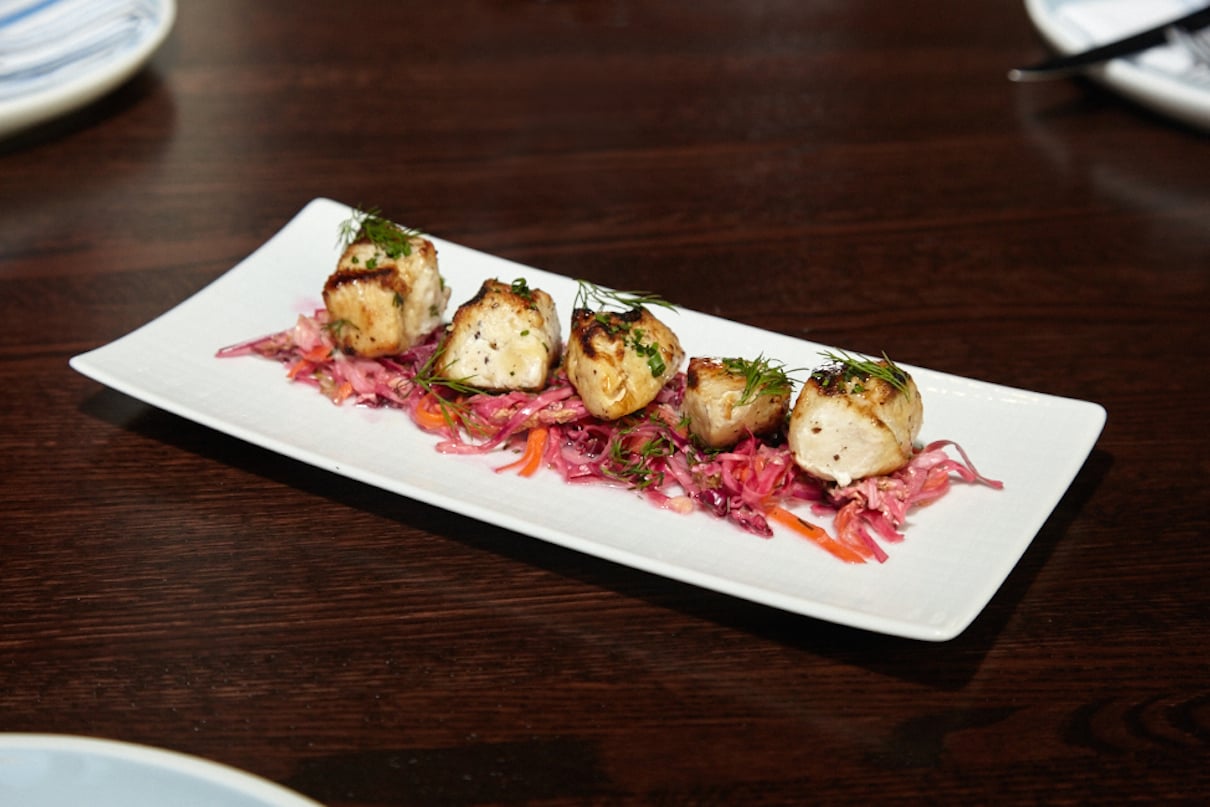Most gastronomical battles can be argued to a standstill: Who produces the best smoked salmon, Ireland or Scotland? Where in Italy will you find the best dried pasta, Abruzzo or Campania? Which is the finest crab, the Pacific Dungeness or the Atlantic blue? Where do they catch the tastiest lobsters, Maine or Nova Scotia?
Trying to find common ground among differing tastes is best summed up by the Latin aphorism “De gustibus non est disputandum.” There is no arguing about tastes.
The exception to that rule is the surprising unanimity among chefs and well-traveled diners asked to name the two finest fish in all of the seas and oceans.
It is not salmon, which, truth be told, is never better than when it is smoked, which rids it of its chalky aftertaste. Neither is it the oily tuna, which is more often consumed raw or canned than cooked. Cod pleases with its delicate sweetness but is hardly noble. And with its thready texture and wan flavor, the swordfish is little more than a white sponge for a mixture of butter and lemon juice. Have we overlooked striped bass—our locally beloved rockfish? A noble fish, but not a sovereign.
The noblest fish in the sea are the turbot and the Dover sole. They are found only in European waters and are the most expensive fish on the market. Depending on the season, the whole Dover sole that constitutes a portion for one at La Chaumière costs chef Patrick Orange $19 to $22. The filets that Yannick Cam uses for his dishes at Le Paradou come from whole turbots that cost $40 to $50 a fish.
To a diner unfamiliar with the market price of Dover sole, La Chaumière’s menu price of $34 may seem high, considering that many of the other main courses are under $20. But it is actually a bargain: If chef Orange applied his regular markup, his Dover sole would cost $50 to $55. Both chefs subsidize the offerings of turbot or Dover sole on their menus through the sale of such cost-efficient items as salads, soups, and desserts.
Salmon and striped bass look noble enough. There is nothing regal about the appearance of a turbot or a Dover sole: Both are oval flatfish with brownish, spotty-patterned skin and both eyes on one side. It is the character and flavor of their flesh that makes them the sea’s finest fish.
The flesh has a similar texture and flavor, with the flavor of the turbot being a little more pronounced. To understand the superior character, think of a flounder or a lemon sole, both flatfish from the Atlantic coast. Their watery, friable flesh has a bland flavor and tends to crumble under the edge of a fork even if they are perfectly cooked. By contrast, turbot and Dover sole are remarkable for the resilience of their tender flesh and its high content of gelatin, which imbues it with a light, pleasant stickiness similar to that of sauces made with highly reduced veal stock. Both fish have a similarly elegant, lightly sweet flavor without the slightest “fishy” taste.
Despite their similarity, the French restaurant critic and food historian Robert Courtine thought them best cooked differently. Criticizing an elaborate preparation of Dover sole in Cent Merveilles de la Cuisine Française, he observed, “The sole, that fish so elegant and rich in itself, has no need for so much flattery. . . . If you want to serve a sole, just cook it as simply as you can.”
In the same volume, devoted to his selection of the 100 best dishes in French cuisine, he says of turbot: “Its flesh is so delicate, is possessed of such a delicious solidity and savor, that it cries out for royal treatment.”
In an age when foie gras is a bestseller even for restaurants that prepare it poorly, why do so few Washington restaurants offer Dover sole and turbot? The high cost to the restaurant dissuades most chefs from serving these regal fish when they can make more money with less risk by offering farm-raised salmon, tuna, and fluke. Cafe Milano serves Dover sole because its clientele is unfazed by the cost of luxuries; Vince MacDonald of Trattoria Etrusco stopped including grilled Dover sole on his daily menu because he couldn’t attract enough customers willing to pay $36 to $42 a portion.
And there is fashion: So few restaurants have offered Dover sole or turbot in recent years that a generation of restaurantgoers has grown up without tasting either.
Washington isn’t the only site of diminishing interest in Dover sole and turbot. They also have become passé in Paris, where they have been replaced in public favor by the more egalitarian cod, the ugly but delicious monkfish, and the never-out-of-fashion skate, whose cousin, the stingray, was responsible for the death of Steve Irwin, Australia’s beloved crocodile hunter.
But shouldn’t lower demand mean lower prices? Apparently not. In August, when the influx of tourists is at its peak in Europe, the supply of turbot and Dover sole diminishes here because of demand by visitors to France and Great Britain. There are still diners who believe that turbot and Dover sole are worth every cent of their price.
Here is where you can dine on these kings of fishes in Washington.
A Bargain at Bistro Français
At DC’s oldest French restaurant, Dover sole is offered only one way: à la meunière. The 31-year-old Bistro Français (3128 M St., NW; 202-338-3830) is so confident about its sources for the fish that it long has been a fixture of the set menu. The menu says it is priced according to the market, but that price is consistently a bargain: Early this September, a substantial portion of fresh Dover sole went for $32.
The neatly fileted fish is sautéed in the classic manner—rather than being plated at the modern, medium-rare stage, it was given enough time in the pan to achieve the fine line of firmness that separates an undercooked fish from an overcooked one. The fish was marred by the kitchen’s tendency to add too much lemon juice to its butter sauce. Request that the kitchen go easy on the lemon and there’s a good chance the waiter will deliver a sole that is sauced as perfectly as it is cooked.
Choices at Cafe Milano
One of the recent celebrities to dine on Dover sole at Cafe Milano (3251 Prospect St., NW; 202-333-6183) was the former British prime minister Margaret Thatcher. At a lunch in September, she ordered her fish sautéed à la meunière.
She picked the right day to dine at the Georgetown restaurant, where Dover sole is offered on an unpredictable basis—usually late in the week and only at night. Depending on the market, Dover sole at Franco Nuschese’s table will cost $34 to $44. The $34 fish was smaller than the Dover soles served at Bistro Français and La Chaumière.
Chef Domenico Cornacchia offers his Dover sole either grilled or as Lady Margaret had it, alla mugnaia—Italian for à la meunière. Order it grilled: Although the sautéed version is accurately cooked, it is not quite as successful a dish as the filets à la meunière at La Chaumière. You could sauce the grilled version at the table with a teaspoon of salmoriglio—a traditional Sicilian sauce comprising olive oil, lemon juice, dried oregano, minced parsley, and garlic—but good as this condiment is on swordfish or tuna or striped bass, it does not marry well with Dover sole. Cafe Milano’s grilled Dover sole is at its best with either a pat of butter skated over its surface when it arrives at table or with a mixture of olive oil, minced parsley, and lemon juice that the kitchen will make on request.
To pique the interest of his cafe-society clientele, chef Cornacchia has begun offering sogliolette—a pair of baby Dover soles served in various preparations. Order them either crisply fried or sautéed in butter alla mugnaia. The third option, sogliolette in guazzetto—poached in white wine, garlic, parsley, and a small amount of diced tomato—is better suited to sea bass or striped bass than to the delicacy of baby Dover sole.
If you are considering either the baby Dover sole or its adult counterpart, do not be dissuaded by the prospect of being confronted by a whole fish. Either size of sole will be boned tableside. If you prefer to do the job yourself, let the waiter know in advance.
La Chaumière’s “Secret Special”
Thirty years after he opened La Chaumière (2813 M St., NW; 202-338-1784), Gerard Pain has sold his cozy urban auberge—the bistro of choice among Georgetown’s old guard—to Martin Lumet and longtime chef Patrick Orange. Lumet, a veteran of the hospitality industry and the wine trade, complements chef Orange’s consistently fine cuisine with well-informed recommendations from his fairly priced wine list.
At $34, the Dover sole at La Chaumière is a bargain. The restaurant has a reputation for reliable cooking at fair prices—most main courses on its dinner menu are under $20. It almost seems embarrassed to mention the availability of Dover sole—it is never listed among the daily specials—but this “secret special” is so well known among regulars that La Chaumière serves more Dover sole than any other place in town.
Chef Orange’s rendition of Dover sole à la meunière is cooked just long enough to firm its flesh while retaining its gelatinous moisture, then sparely sauced with butter with an edge of lemon juice. It is a perfect interpretation of a great French classic.
A fish as low in fat as Dover sole presents a challenge of timing when cooked on a grill. La Chaumière’s treatment, with its dark lattice pattern of grill marks, is firm and properly moist. Unsauced, its flavor is so pure that it would be a shame to distort it with a tableside addition of lemon. Ask that the kitchen send out a small amount of maître d’hôtel butter. When the sole is served, skate a bit across its surface to create a light gloss. The butter conveys the natural flavor of the fish, while the lightly acid edge of the lemon juice in the mixture leavens the weight of the butter.
Although he dabbles in modern improvisations for a few daily specials, Patrick Orange is one of the last French chefs in town who works in the classic style. Normally he offers Dover sole sautéed or grilled, but he will entertain requests for other classic preparations. At a late weekday lunch, he honored a request for Dover sole in a preparation of his choice with a flawless rendition of sole à la bonne femme. Poached filets were scattered over with thinly sliced button mushrooms and napped with a sauce made from a reduction of the fish’s poaching liquid, which is given a medium-bodied consistency by a last-minute addition of butter. The refined flavor of Dover sole is emphasized by the generous portion of button mushrooms, which are poached with the fish in white wine. Mushrooms are packed with natural monosodium glutamate (MSG) and boost the flavor of ingredients cooked with them.
Dover sole with noodles—Filets de Sole aux Nouilles—is not among Escoffier’s classic treatments, but it is a masterpiece of excess, traditional to the cuisine of Alsace. Available with several days’ notice, it is an extravagance of sole filets poached in a mixture of fish stock and white wine with minced shallots and diced tomato. Served over thin, freshly made noodles, the dish is lightly blanketed with a sauce made from the fish’s reduced poaching liquid, heavy cream, and hollandaise sauce. Before it is brought to table, the dish is lightly browned under a broiler and garnished with poached crayfish tails.
Sensational as it is, a whole Dover sole prepared this way challenges the most robust appetite. Prefaced by Patrick Orange’s excellent terrine of duck foie gras, it provides a substantial main course for two. Or it could provide a luxurious first course for four. La Chaumière’s wine list offers a bottle that is at once a complement and a foil to this exquisitely rich preparation: Pierre Sparr’s elegant Gewürztraminer.
Turbot Nonpareil at le Paradou
Le Paradou (678 Indiana Ave., NW; 202-347-6780) is the only restaurant in Washington that offers turbot on its set menu. Dover sole is conspicuously absent. Chef Yannick Cam says the quality of the Dover sole being offered by his purveyors is not up to his standards.
From the offerings on the set menu, you can compose your own six- or nine-course meal. But the best meals are those for which you decide on the number of courses and let chef Cam compose the menu. Alert the waiter if you dislike such ingredients as sea urchins, sweetbreads, raw seafood, or foie gras—the chef will avoid surprising you.
All of the turbot preparations described here were part of tasting menus the chef was asked to compose at his discretion. Over the course of four meals, chef Cam’s variations on the turbot theme were flawless.
While many diners dismiss sea urchins as “too fishy,” fans think their iodine-suffused aroma evokes the ocean. In two of Cam’s turbot treatments, the chef demonstrated the affinity between the spiny creatures of the shoreline and the regal fish.
In the first dish, the elegant flavor of roasted filets of turbot was emphasized by a parsley-butter sauce. Twin garnishes of sea-urchin roe and caramelized slice of sea scallop served as briny condiments. In the second preparation—part of a six-course tasting menu—a single filet of turbot was presented in a spare pool of urchin cream sauce and topped with a rounded demitasse spoonful of osetra caviar. Despite the difference of their sauces and garnishes, both dishes achieved a harmonic convergence of the primal flavors found in the seas and oceans of the world—the sweetness of crustaceans and the noblest fish, and the salt and iodine that pervade their environment.
The hallmark of Yannick Cam’s cuisine is its finesse. Few chefs exhibit as thorough a grasp of the nuances of flavor that achieve balance in a dish.
At one lunch, the chef was asked to prepare turbot in a manner that would complement a glass of Le Paradou’s house Sauternes, Château de Veyres 2003. Pairing a richly sweet wine with seafood is not as strange as it seems. Throughout most of the 19th century and up to the late 1930s, Château d’Yquem, the greatest of Sauternes, was customarily paired with turbot and Dover sole at important meals.
No Sauternes lover would mistake a Château de Veyres for an Yquem, but the little-known chateau in 2003 produced a remarkably full-bodied wine whose fruit-acid balance should be the envy of many better-known wines from the region.
Cam sauced the turbot with a reduction of Château de Veyres—the wine he normally uses to make Sauternes sauces—and cream, then finished with a garnish of tiny fig halves and two slivers of vanilla bean. It was a textbook matching of a dish to a challenging wine. The reduction of wine and cream tamed the weight and sweetness of the Sauternes in the glass, making its acid edge more apparent, which pushed the sweetness of the turbot to the foreground.
A course of turbot sauced with a creamy emulsion flavored with the juice of a blood orange might sound like a bit of retro nouvelle cuisine reminiscent of the fruit-sauced creations of young chefs on the French Riviera in the early 1980s. But the combination of oranges—or their juice—and turbot dates back to the 19th century, when Alexandre Dumas included a recipe for turbot à la bigarade, sauced with a reduction of fish stock and the juice of bitter oranges, in his Grand Dictionnaire de Cuisine.
At Le Paradou, turbot filets with blood-orange sauce is neither 1980s retro-chic nor a museum piece from the 19th century. The weight of the sauce and its ratio of sweetness to acid make it an exemplar of Yannick Cam’s cuisine, a dish whose effect is greater than the sum of its outwardly simple parts—and the work of a chef who long has understood that a sauce’s purpose is to spotlight the flavor of the main ingredient.

















